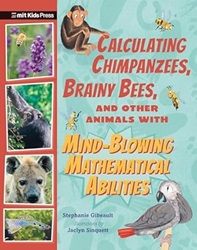
 Calculating Chimpanzees, Brainy Bees,
Calculating Chimpanzees, Brainy Bees,and Other Animals with Mind-Blowing Mathematical Abilities
Review posted December 27, 2024.
MIT Kids Press, 2024. 88 pages.
Review written December 18, 2024, from my own copy, sent to me by the publisher.
Starred Review
2024 Sonderbooks Standout:
#8 Children's Nonfiction
Here's a book that tells a fascinating story about what goes into mathematical thinking - because it's telling how scientists figure out how much of it animals are capable of.
First, they look at guppies. Yes, fish! Can guppies, with their tiny brains, count? Well, it turns out that when faced with two alternatives, guppies can choose the larger shoal to swim near (the better to not be eaten by predators). While explaining the experiments the scientists did, we learn about relative numerosity judgment, object-tracking systems, approximate number systems, and the numerical size and numerical distance effects.
Next up are hyenas. Researchers recorded the whoops of different hyenas and simulated a group approaching with hyena whoops. The hyenas would change behavior if there were more or fewer hyenas in the simulated group than their own group. They were wary with more intruders and aggressive with fewer. Along the way, the reader learns about subitizing and all the different things that happen when a human counts.
Chapter 3 is about a highly intelligent African grey parrot named Alex and how he even learned to use numerals and do simple math, even when the question was given with numerals. The super-interesting story of how they designed experiments for Alex to show he really understood what he was doing also teach the reader about equivalence (swapping four objects for the numeral 4, for example) and ordinality.
Next was a chapter about chimpanzees, and, yes, they can do calculations. Some experiments they described involved hiding groups of oranges in different places - and the smart chimp could pick the number that matched the total number of oranges. Even more amazing, when they put numerals in place of the oranges, the chimp still picked the correct total the very first time they tried it. This chapter covers ways humans - and chimps - do addition (though we don't know which one this chimp was using) - counting all and counting on.
The final chapter was about honeybees. The scientists used sugar-water treats to train bees to choose the smaller number when presented with pictures of shapes - and the bees could do it even when the card had zero objects. Along the way in this chapter, the author talks about the concept of zero and how it did take humans a long time to grasp it.
And for all of the chapters there's added value of an interview with the scientists who did the experiment plus a page for each chapter of related experiments you can try with a friend. The introduction and sections threaded through all the chapters include the story of the horse Clever Hans and how scientists use precautions to be sure they aren't tipping the animals off.
I thought this whole book was completely fascinating, and it's written in an engaging way that should capture the attention of the 9- to 12-year-olds it's designed for. Really interesting stuff! You'll gain insight on the thought processes behind the way you - and animals - do math.
